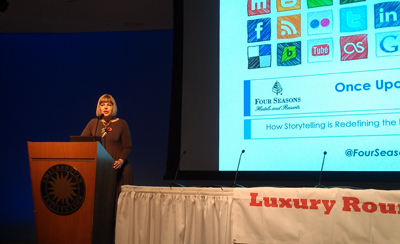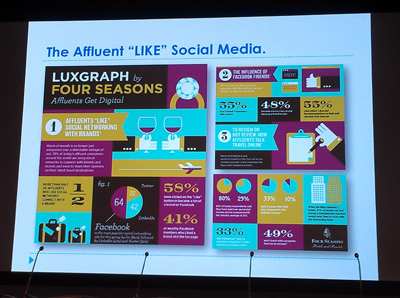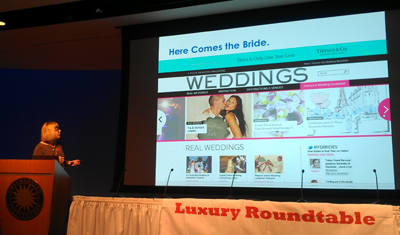A Four Seasons Hotels and Resorts executive said during the Luxury Roundtable: State of Luxury 2013 conference that marketers need to understand where today's luxury consumers are engaging and deliver the brand story directly to them.
During the "How Storytelling is the New Defining Luxury Experience" session, the executive revealed how Four Seasons transitioned to a storytelling brand through its use of social media and digital content. Though it is often impossible to measure these efforts' direct impact on sales, marketers need to interact with their audience through dialogue that extends on- and offline to surround them with the brand experience and convince them of its authenticity.
"It is all about customization," said Elizabeth Pizzinato, senior vice president of marketing and communications, Four Seasons Hotels and Resorts. "It is an overused buzzword these days, but it is truly what people want.
"If they communicate with you – via mobile, social media or even fax – you need to understand that and use that as a marketer," she said.
New identity
Four Seasons became a digital storyteller to overcome economic uncertainties and reach a broad global audience.
The brand has been present on social media since 2009 when consumers began to expect to be engaged 24 hours a day.
For many brands, what was historically spent on advertising is now being spent on digital advertising and engaging consumers on digital channels.
Consumers and marketers alike are communicating with small bites of information. For instance, mobile video platform Vine propelled the popularity of the six-second story.
"We are consuming information in very small, snackable delights because that's all we have time for," Ms. Pizzinato said.
Therefore, luxury brands cannot be clueless about social media. Marketers should work to understand where their consumers are engaging, who they are talking to, what they are reading and what they are seeing.
Despite these changes among luxury marketers' target audience, one constant is that recommendations from friends and family drive sales. It is the most powerful motivator to book travel, per Ms. Pizzinato and today, the number of review sites is testament to that.
The affluent like social media and they will not stay at a hotel that does not have an online review.
Four Seasons forms its digital storytelling strategy by looking into the future and thinking what is next on the horizon.
There are a lot of luxury marketers that are in the same space, so what Four Seasons tries to do in the luxury space is to help the consumer make a decision.
Content strategy
Four Seasons focuses on six pillars to shape its content strategy, which extends from the corporate level to each of its properties.
First, the brand manages content in one place. It has a central team that gets content to all digital communications channels.
The Web site is its foundation; it is the place where consumers know to go. But it is also the channel that drives people out to Four Seasons' online magazine where content is fresh and category-specific.
Another part of Four Seasons' content strategy is leveraging user-generated content, while another part is engaging experiences both on and offline. These parts of the strategy intersect as consumers are interacting with the brand during events such as its Virtual Wine Tasting.
The tasting was held via Twitter and hosted by sommeliers at five properties, bringing a vertical experience and the brand's expertise to consumers in a really engaging way, per Ms. Pizzinato.
In addition, Four Seasons hosted concurrent tweet-ups at participating properties including the Virtual Wine Tasting.
The last two ways that Four Seasons leverages its content strategy is to have a point of view and a personality.
Four Seasons' content strategy also has a point of view. Part of this is finding new distribution channels, such as a publisher would do, to make the product more widespread.
If consumers do not find the Four Seasons brand online, it would mean that the brand is not reaching them. Therefore, Four Seasons distributes its magazine not only through print and online, but also on Zinio and Flipboard.
One effort from which the brand saw much traction in terms of brand personality and consumer engagement was its bridal campaign.
Four Seasons established a themed edition of its and themed Twitter and Pinterest accounts dedicated to sharing expert tips from the hotel's staff and stories from real Four Seasons brides (see story).
Brand partnerships help to drive home its personality. In fact, Four Seasons will partner with brands such as Marchesa for this spring's bridal campaign.
"It's not about marking – coming up with things and hoping it happens," Ms. Pizzinato said. "We are highly engaged with the operation side of the business and that is what has made it work so successfully."
About the Author
Tricia Carr is an editorial assistant on Luxury Daily. Her beats are apparel and accessories, arts and entertainment, education, food and beverage, fragrance and personal care, government, healthcare, home furnishings, jewelry, legal/privacy and nonprofits. Reach her at tricia@napean.com.
Source: Luxury Daily















